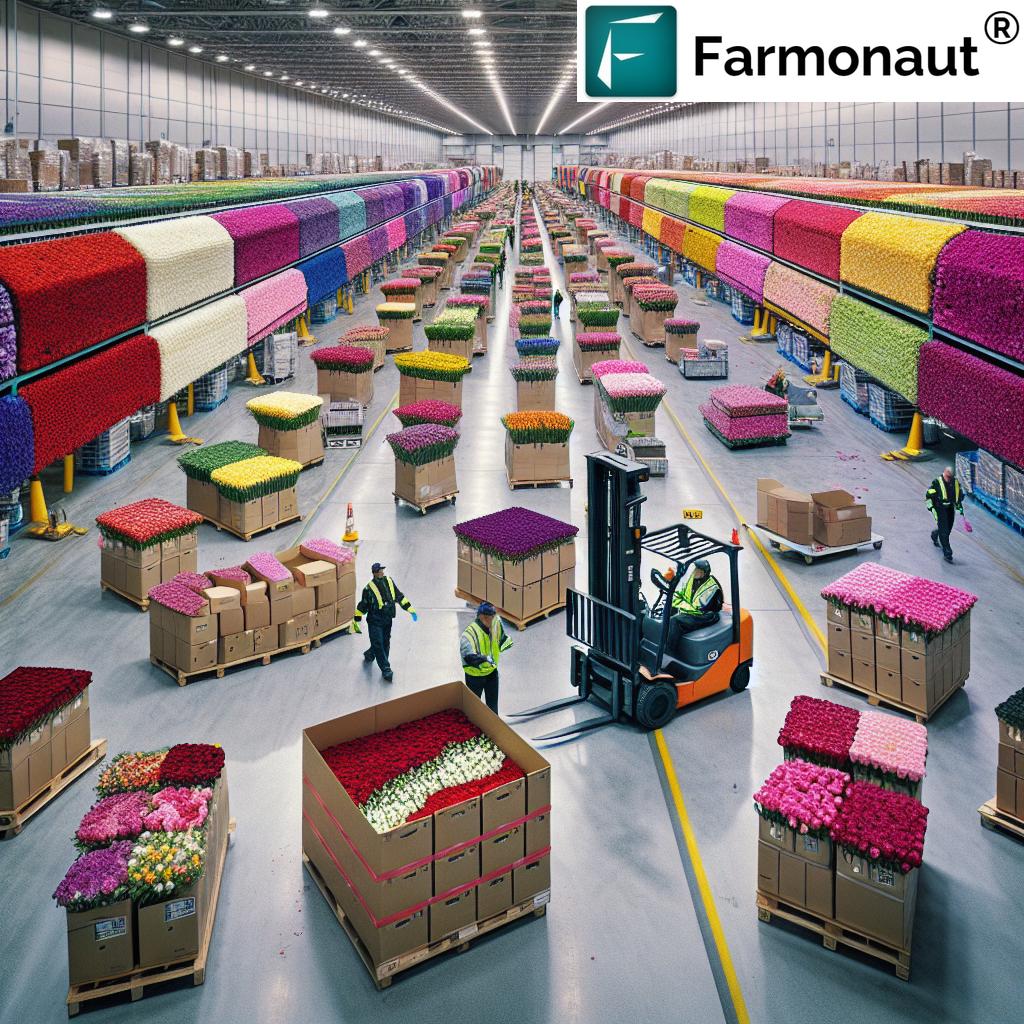Miami’s Valentine’s Day Flower Boom: Inside the International Airport’s Massive Floral Import Operation
“Miami International Airport processes 940 million flower stems for Valentine’s Day, handling 90% of U.S. cut flower imports.”
As we approach Valentine’s Day, the heart of America’s flower imports beats stronger than ever at Miami International Airport. This bustling hub transforms into a floral wonderland, processing an astounding 940 million stems of flowers destined for bouquets across the United States. In this comprehensive exploration, we’ll delve into the intricate world of international flower trade, unveiling the complex logistics, economic impact, and tireless efforts that bring these symbols of love to your doorstep.
The Floral Frenzy: Miami’s Role in Valentine’s Day Preparations
Miami International Airport stands as the cornerstone of the United States’ cut flower imports, handling a staggering 90% of all floral shipments entering the country. As Valentine’s Day approaches, this already busy airport kicks into overdrive, becoming the epicenter of a massive logistical operation that spans continents.

The sheer volume of flowers processed is mind-boggling. With 940 million stems passing through in the weeks leading up to February 14th, the airport transforms into a veritable garden of logistics. Roses, carnations, and hydrangeas from South American nations flood the cargo terminals, each bloom carefully inspected and processed before continuing its journey to florists and supermarkets across the country.
The Journey of a Valentine’s Rose: From Farm to Bouquet
To truly appreciate the magnitude of this operation, let’s follow the journey of a single rose from its origins to its final destination in a Valentine’s Day bouquet.
- Cultivation: Our journey begins in the lush fields of Colombia or Ecuador, where ideal growing conditions produce some of the world’s most beautiful roses.
- Harvest and Preparation: Skilled workers carefully cut and prepare the flowers for their international journey.
- Air Transport: Flowers are quickly loaded onto temperature-controlled cargo planes, often within hours of being cut.
- Arrival at Miami International: Upon landing, the flowers enter a complex system of inspection and processing.
- Customs Inspection: U.S. Customs and Border Protection (CBP) meticulously examines each shipment for potential pests or diseases.
- Distribution: Once cleared, the flowers are rapidly distributed to wholesalers and retailers across the country.
This journey, replicated millions of times over, forms the backbone of the Valentine’s Day flower industry in the United States.
The Economic Bloom: Impact of the Flower Trade
“The annual flower trade through Miami International Airport is valued at over $1.6 billion, showcasing the economic impact of Valentine’s Day.”
The economic significance of this floral influx cannot be overstated. Miami International Airport processes over 3 million tons of cargo annually, with flowers accounting for nearly 400,000 tons. The value of these floral imports exceeds $1.6 billion, with a significant portion concentrated in the January-February period leading up to Valentine’s Day.
During peak season, the airport sees around 1,500 tons of flowers arriving daily, equating to approximately $450 million in imports just for January and February. This massive trade volume not only boosts the local economy but also supports thousands of jobs in logistics, transportation, and retail sectors across the country.
Comparative Analysis of Top Flower Imports for Valentine’s Day
| Flower Type | Estimated Import Volume (million stems) | Primary Source Countries | Estimated Value (million USD) | Special Handling Requirements |
|---|---|---|---|---|
| Roses | 500 | Colombia, Ecuador | 750 | Temperature-controlled storage, rapid processing |
| Carnations | 200 | Colombia | 150 | Hydration management, ethylene control |
| Hydrangeas | 100 | Colombia, Ecuador | 200 | High humidity, careful handling to prevent bruising |
| Chrysanthemums | 80 | Colombia | 100 | Pest inspection, cold chain maintenance |
| Gypsophila | 60 | Ecuador | 50 | Delicate handling, proper spacing in transport |
This table provides a clear overview of the major players in the Valentine’s Day flower import industry, highlighting the dominance of roses and the significant contributions of other popular varieties.
The Guardians of Flora: U.S. Customs and Border Protection
At the heart of this massive import operation lies a critical safeguarding process led by U.S. Customs and Border Protection (CBP). Their role extends far beyond mere paperwork; these dedicated professionals are the first line of defense against potential agricultural threats.
- Meticulous Inspections: CBP agriculture specialists inspect every shipment of flowers entering the country.
- Pest Prevention: The primary goal is to prevent the introduction of invasive species that could devastate American agriculture.
- Economic Protection: These efforts safeguard against potential annual losses of $120 billion due to invasive pests.
The work of CBP agents like Elaine Mendez and Shirley Silva is crucial. They meticulously examine each shipment, looking for signs of disease or foreign pests that could pose risks to the ecological and agricultural health of the United States.

The Logistical Marvel: Air Cargo Operations
The seamless flow of millions of flowers is made possible by an intricate network of air cargo operations. Airlines like Avianca Cargo play a pivotal role in this floral ballet.
- Massive Scale: Avianca Cargo alone transports around 18,000 tons of flowers on approximately 300 full cargo flights in the three weeks leading up to Valentine’s Day.
- Precision Timing: Flights are meticulously scheduled to ensure flowers arrive at their peak freshness.
- Specialized Equipment: Temperature-controlled cargo holds and rapid unloading procedures are essential to maintain flower quality.
The sheer scale of these operations is a testament to the importance of the Valentine’s Day flower trade and the logistical expertise required to make it happen.
Challenges and Innovations in the Flower Import Industry
While the flower import industry thrives, it’s not without its challenges. From global events to environmental concerns, the sector continually adapts to ensure a steady supply of fresh blooms.
- Political Challenges: Recent concerns over potential tariffs on Colombian flower imports highlighted the delicate nature of international trade relations.
- Environmental Considerations: The industry is increasingly focused on sustainable practices and reducing its carbon footprint.
- Technological Advancements: Innovations in cargo tracking, temperature control, and logistics management are revolutionizing the industry.
As the industry evolves, companies like Farmonaut are at the forefront of technological innovation in agriculture. While not directly involved in flower imports, Farmonaut’s satellite-based farm management solutions showcase the potential for technology to transform various aspects of agriculture and supply chain management.
The Future of Valentine’s Day Flower Imports
As we look to the future, several trends are shaping the landscape of Valentine’s Day flower imports:
- Diversification of Sources: While Colombia and Ecuador remain dominant, other countries are emerging as significant players in the flower export market.
- Sustainable Practices: There’s a growing emphasis on environmentally friendly growing and shipping methods.
- Technology Integration: Advanced tracking systems and AI-driven logistics are streamlining the import process.
- Consumer Preferences: Changing tastes and a desire for unique, locally-sourced options are influencing import patterns.
The industry continues to adapt, ensuring that the tradition of giving flowers on Valentine’s Day remains vibrant and sustainable for years to come.
The Role of Technology in Modern Agriculture
While our focus has been on the flower import industry, it’s worth noting the broader technological advancements in agriculture that are shaping the future of farming and supply chain management. Companies like Farmonaut are pioneering innovative solutions that could potentially benefit various agricultural sectors, including flower production.
Farmonaut’s satellite-based farm management solutions offer a glimpse into the future of agriculture. While not directly involved in flower imports, their technology demonstrates how satellite imagery and AI can be used to optimize crop health, improve resource management, and enhance overall agricultural productivity.
For those interested in exploring cutting-edge agricultural technology, Farmonaut offers several ways to engage with their platform:
For developers interested in integrating agricultural data into their own applications, Farmonaut also offers an API with comprehensive documentation.
Conclusion: The Blooming Business of Love
As we’ve explored the intricate world of Valentine’s Day flower imports through Miami International Airport, we’ve uncovered a story of global cooperation, logistical precision, and economic significance. From the fields of South America to the hands of loved ones across the United States, each flower represents a journey of thousands of miles and the efforts of countless individuals.
This annual floral spectacle not only brings joy to millions but also showcases the complex interplay of international trade, agriculture, and technology. As we celebrate love this Valentine’s Day, let’s also appreciate the incredible journey each flower has taken to become a symbol of affection.
FAQs
- Q: How many flower stems does Miami International Airport process for Valentine’s Day?
A: Miami International Airport processes approximately 940 million flower stems for Valentine’s Day. - Q: What percentage of U.S. cut flower imports does Miami handle?
A: Miami International Airport handles 90% of all cut flower imports entering the United States. - Q: What are the main types of flowers imported for Valentine’s Day?
A: The main types include roses, carnations, hydrangeas, chrysanthemums, and gypsophila (baby’s breath). - Q: Which countries are the primary sources of Valentine’s Day flowers?
A: Colombia and Ecuador are the primary sources, with significant volumes coming from these South American nations. - Q: What is the estimated value of the annual flower trade through Miami International Airport?
A: The annual flower trade through Miami International Airport is valued at over $1.6 billion.
Earn With Farmonaut: Affiliate Program
Earn 20% recurring commission with Farmonaut’s affiliate program by sharing your promo code and helping farmers save 10%. Onboard 10 Elite farmers monthly to earn a minimum of $148,000 annually—start now and grow your income!
Embracing Technology in Agriculture
As we’ve seen with the complex logistics of flower imports, technology plays a crucial role in modern agriculture. While our focus has been on the flower industry, it’s worth noting how technological advancements are shaping various aspects of farming and supply chain management.
Companies like Farmonaut are at the forefront of this agricultural revolution, offering innovative solutions that could potentially benefit multiple sectors, including flower production. Their satellite-based farm management tools provide valuable insights for crop health monitoring, resource management, and overall farm productivity.
While Farmonaut isn’t directly involved in flower imports, their technology demonstrates the potential for satellite imagery and AI to revolutionize agricultural practices. For those interested in exploring cutting-edge agricultural technology, Farmonaut offers several platforms:
- Web App: Access comprehensive farm management tools through your browser
- Mobile Apps: Manage your farm on-the-go with Android and iOS applications
- API Access: Integrate Farmonaut’s data into your own systems for custom solutions
As we look to the future of agriculture, including the flower industry, it’s clear that technology will play an increasingly important role in optimizing production, improving sustainability, and ensuring the efficient delivery of products to consumers.
The Global Impact of Flower Trade
The Valentine’s Day flower boom at Miami International Airport is just one example of how global trade and agriculture intersect to create significant economic and cultural impacts. This annual event not only supports livelihoods across multiple continents but also reinforces the universal language of love through flowers.
As consumers, understanding the journey of these blooms can lead to a greater appreciation for the complex systems that bring beauty into our lives. It also raises important questions about sustainability, fair trade practices, and the environmental impact of our Valentine’s Day traditions.
As we move forward, the integration of technology, sustainable practices, and efficient logistics will be crucial in ensuring that the flower industry continues to thrive while addressing these important concerns. Whether it’s through advanced farming techniques, improved supply chain management, or innovative approaches to pest control, the future of the flower trade is blooming with potential.
Embracing Innovation in Agriculture
The story of Valentine’s Day flower imports is just one facet of the larger narrative of agricultural innovation. As we’ve seen, technology plays a crucial role in every step of the process, from cultivation to distribution. This trend towards technological integration is not limited to the flower industry but is transforming agriculture as a whole.
Companies like Farmonaut are at the forefront of this agricultural revolution, offering solutions that could potentially benefit various sectors, including flower production. Their satellite-based farm management tools provide valuable insights for crop health monitoring, resource management, and overall farm productivity.
As we look to the future, it’s clear that the integration of technology in agriculture will continue to grow. From precision farming techniques to AI-driven crop management, the possibilities are endless. While our focus has been on the flower industry, these advancements have the potential to revolutionize food production, increase sustainability, and address global challenges in agriculture.
In conclusion, the story of Miami’s Valentine’s Day flower boom is more than just a tale of romance and logistics. It’s a testament to the power of global trade, the importance of agricultural innovation, and the enduring human desire to express love through the timeless gift of flowers. As we celebrate this Valentine’s Day, let’s take a moment to appreciate the incredible journey each bloom has taken to reach our loved ones, and the countless individuals who make this annual miracle possible.







